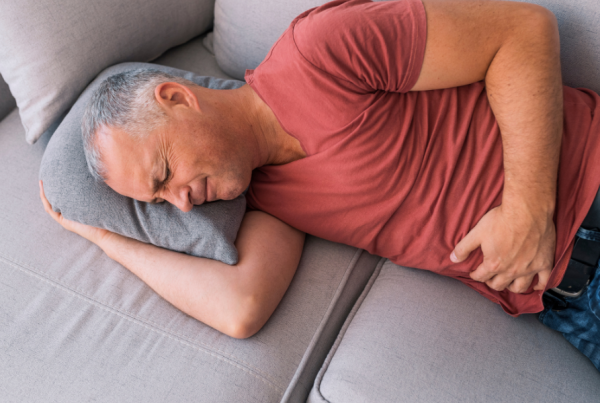Core Weakness
Move Better. Live Fuller. Your Wellness Journey Starts Here.
Schedule a FREE Discovery Call!
What Is Core Weakness?
Core weakness is a lack in the muscle strength or coordination needed to properly support stability, posture, movement, and other functions. It is less about having physically appealing abdominals and more about the core function itself—being able to enjoy activities, move without pain, and avoid injury. The “core” refers to a variety of muscle groups that allow stability and balance of the body. It is made up of the following structures:
- Rectus abdominis (the “six pack”)
- Transverse abdominis (deeper abdominal muscles)
- Obliques (muscles towards the sides of your torso)
- Multifidus (muscle on the sides of the spine)
- Diaphragm (muscle that allows for breathing and controls internal pressure)
- Pelvic floor muscles (a group of muscles located in the pelvis)

All of these muscles coordinate to allow for healthy, efficient movement. This can encapsulate a lot of different movements—getting up from sitting, lifting up items, bending over, walking, playing sports, and more. The core is very interconnected with the pelvic floor, meaning it affects functions like urination, defecation, and sexual activity, too!
As you can see, the core is very involved in daily life, so no matter if you are a more sedentary individual or a professional athlete, you need your core to be in good health for daily tasks and general health. When the core muscle groups are not in good health, they are unable to properly engage or coordinate together, and cannot provide proper support for your spine, trunk, and pelvis. This leads to difficulty with daily movements and other symptoms such as:
- Back, hip, or pelvic pain
- Overuse injuries
- Poor posture
- Pelvic floor dysfunction (incontinence, painful sex, prolapse)
- And more
Now that you understand the effects of core weakness, we’ll discuss what may cause this weakness and the symptoms associated with it.
What Causes Core Weakness?
Core weakness can be caused by a variety of factors. It can be a mixture of daily habits, past medical histories, pre-existing conditions, and more. Some examples include the following:
Pelvic Floor Dysfunction
The pelvic floor is an essential part of core strength and stability. This group of pelvic muscles provide support and stability for the entire upper body, protect your pelvic organs, and allow for many different important functions. It is very interconnected with other areas of the body, such as the core, lower back, hips, and more—so when problems arise with this group of muscles, it can cause problems in other places, too.
Having weakness or poor coordination in the pelvic floor muscles makes it difficult for them to properly support the core muscles and coordinate with them to provide movement and function. On the other hand, overly tight muscles can create pain, discomfort, poor muscle function, and impaired coordination with the core.
Pelvic floor dysfunction not only disrupts your core health, but can cause other symptoms of incontinence, constipation, pelvic pain, painful sex, and more. If you experience symptoms that disrupt your bladder, bowel, or sexual health, you have signs of pelvic floor dysfunction—meaning your pelvic floor is likely also impacting your core strength.
Pregnancy, Surgery, or Injury
Previous surgeries, injuries, or pregnancies can have a significant effect on the core and pelvic floor. These factors may weaken the muscles, affect coordination and mobility, create scar tissue, and affect posture. Some more specific examples can include:
- Abdominal surgeries or pelvic surgeries such as hysterectomies or c-sections.
- Pelvic floor trauma from pregnancy or vaginal delivery. This can include general pelvic floor weakness or conditions like diastasis recti.
- Injuries or conditions like chronic low back pain, spine injuries, or pelvic trauma can create poor posture or impaired movement mechanics.
- Neurological conditions can affect an individual’s ability to coordinate muscles or move efficiently, and may create other problems such as pelvic floor dysfunction.
Behavioral Factors
Many daily behaviors or habits can have a negative impact on your core health and pelvic floor coordination, even habits you may not realize are harmful. This can include factors such as:
- Poor breathing technique: Improper breathing technique disrupts the coordination between the pelvic floor and diaphragm, which can create weakness and affect tension in the core muscles.
- Straining: Constipation, straining on the toilet, or improper lifting technique can harm both the core and pelvic floor, creating dysfunction in those muscle groups.
- Poor posture: Poor posture, spinal misalignment, or pelvic misalignment can put excess pressure on the abdominals or pelvic floor and even affect your breathing patterns.
- Muscle imbalances: Being sedentary or not engaging all muscle groups during exercise can lead to muscle imbalances that create tension on the core or pelvic floor. Having poor form during exercise (especially high-intensity exercises) can contribute to imbalances or even injury.
Aging
Aging naturally affects the body’s tissues—when coupled with a sedentary lifestyle, the core muscle groups and pelvic floor can weaken over time, creating dysfunction, pain, and weakness. Regularly engaging in exercise and stretching can support healthy muscle function in the long run!
Physical Therapy for Core Weakness
Physical therapy for core weakness takes both an orthopedic and pelvic floor focused approach to treatment, as the muscle groups in these areas are interconnected and rely on each other to function efficiently. To improve core weakness or dysfunction, physical therapy treatment looks to address problems with posture, muscle balance, movement mechanics, lifestyle factors, and more. When engaging in physical therapy to address these factors of core weakness, you can expect treatment methods such as:
Core Strengthening
To address core weakness, your physical therapist will curate an exercise and stretching routine to improve the function and flexibility of your core muscles. They’ll start you off on low-load strengthening exercises, but you can expect your routine to become progressively more difficult and complex.
Next, your physical therapist will integrate exercises that don’t just focus on single muscle groups, but multiple groups simultaneously, to improve your coordination and encourage correct muscle activation.
Breathing and Postural Training
Core strengthening isn’t just about doing exercises and building muscle. Your core strength and overall health also depends on other aspects, such as how you breath and your posture during these exercises.
Proper posture and breathing techniques are essential to encouraging good core health, preventing injury, and reducing strain on the body. Your physical therapist will evaluate both your breathing technique and form during exercise (and while resting, too) which will ensure you have good intra-abdominal pressure regulation and reduced risk of injury.
Pelvic Floor Training
While training the core muscle groups is very important, these muscles don’t perform alone. They coordinate with the pelvic floor in order to allow movement, as we mentioned earlier. This means anytime you walk, run, jump, squat, lift, or perform other exercises, the pelvic floor is helping you!
To coordinate with the core and perform these movements properly, the pelvic floor needs to be in good health. If there is weakness, tightness, inflexibility, or poor coordination of the pelvic floor muscles, they will struggle to function. Your physical therapist will examine your pelvic floor health to determine your individual needs, and then lead you through treatments to regain control and coordination of those important muscles.
Once you become more aware of your pelvic floor and have regained control over relaxing and contracting these muscles voluntarily, you will be able to engage in exercises, stretching, and relaxation activities to encourage good health and muscle balance.
Your physical therapist will lead you through curated movements and exercises that will help you properly engage and coordinate your core muscles and pelvic floor muscles simultaneously. This is especially important to practice during exercise and movements like walking, bending, or lifting to build core stability and coordination.
Pain Management and Manual Therapy
Many individuals with core weakness experience pain in the back or pelvis due to the lack of stability or support from the core. Without proper core engagement, other areas of the body compensate for your movements, which creates muscle strain and tightness. To relieve the pain created by this strain, your physical therapist can provide a variety of pain-relieving treatments—while, of course, addressing the root of the issue with other treatments.
Some examples of treatments utilized to address pain include therapeutic modalities such as cold or heat therapy, electric muscle stimulation, or manual therapy. Manual therapy refers to treatments that mobilize tissues (muscles, nerves, ligaments, etc.) in order to improve flexibility, reduce tension, and address painful trigger points.
These treatments can be provided via hands-on techniques or with tools. At Hive, our providers use manual therapies such as tissue scraping, dry needling, and cupping—which can provide other benefits such as improved blood flow and improved muscle function.
Manual therapies are also very beneficial for individuals with scar tissue from past injuries or surgeries (such as c-sections or other abdominal surgeries). The gentle mobilization of tissues can improve the comfort, mobility, and flexibility of scar tissue, reducing restriction and allowing for better muscle function.
Behavioral Modifications
There are many daily behaviors or habits that can affect your core or pelvic floor health, as mentioned before. You may be performing these habits very often, yet unknowingly harming your muscle health. For example, while we’ve discussed the importance of good form during exercise, day-to-day posture matters, too. How you sit, stand, walk, or even your posture on the toilet can affect your core and pelvic floor health by creating strain and muscle tension.
Many restroom habits can affect your pelvic floor health and lead to dysfunction, including things like poor toilet posture, straining during bowel movements, holding urine too long, urinating too frequently, and more. Your physical therapist will be sure to educate you on these behaviors, identify any you may be doing, and correct them with treatment.
Education and At-Home Care
Your Hive physical therapist cares about your long-term health, too—therefore, they’ll provide you with plenty of education and strategies for at-home care. This can include exercises, stretches, breathing techniques, and other activities to practice at home.
You’ll want to practice these at-home strategies regularly to support core function and comfort in the long run! It may be necessary to check in with your physical therapist occasionally in order to address any new symptoms that occur with bodily changes or life events.
The physical therapists at Hive Therapy and Wellness are dedicated to providing a holistic and individualized treatment experience for all patients. While under our care, you can expect to engage in any of the following treatment methods to address core weakness:
- Neuromuscular re-education
- Manual therapy
- Exercise prescription
- Dry needling
- Cupping
- Tissue scraping
- Behavioral modifications
- Therapeutic activities
- Electrical muscle stimulation
- Spinal manipulation
- Therapeutic modalities
- Biofeedback
Core weakness is a lack in the muscle strength or coordination needed to properly support stability, posture, movement, and other functions.
It is less about having physically appealing abdominals and more about the core function itself—being able to enjoy activities, move without pain, and avoid injury.
The “core” refers to a variety of muscle groups that allow stability and balance of the body. It is made up of the following structures:
- Rectus abdominis (the “six pack”)
- Transverse abdominis (deeper abdominal muscles)
- Obliques (muscles towards the sides of your torso)
- Multifidus (muscle on the sides of the spine)
- Diaphragm (muscle that allows for breathing and controls internal pressure)
- Pelvic floor muscles (a group of muscles located in the pelvis)
All of these muscles coordinate to allow for healthy, efficient movement. This can encapsulate a lot of different movements—getting up from sitting, lifting up items, bending over, walking, playing sports, and more.
The core is very interconnected with the pelvic floor, meaning it affects functions like urination, defecation, and sexual activity, too!
As you can see, the core is very involved in daily life, so no matter if you are a more sedentary individual or a professional athlete, you need your core to be in good health for daily tasks and general health.
When the core muscle groups are not in good health, they are unable to properly engage or coordinate together, and cannot provide proper support for your spine, trunk, and pelvis.
This leads to difficulty with daily movements and other symptoms such as:
- Back, hip, or pelvic pain
- Overuse injuries
- Poor posture
- Pelvic floor dysfunction (incontinence, painful sex, prolapse)
- And more
Now that you understand the effects of core weakness, we’ll discuss what may cause this weakness and the symptoms associated with it.
Core weakness can be caused by a variety of factors. It can be a mixture of daily habits, past medical histories, pre-existing conditions, and more. Some examples include the following:
Pelvic Floor Dysfunction
The pelvic floor is an essential part of core strength and stability. This group of pelvic muscles provide support and stability for the entire upper body, protect your pelvic organs, and allow for many different important functions.
It is very interconnected with other areas of the body, such as the core, lower back, hips, and more—so when problems arise with this group of muscles, it can cause problems in other places, too.
Having weakness or poor coordination in the pelvic floor muscles makes it difficult for them to properly support the core muscles and coordinate with them to provide movement and function.
On the other hand, overly tight muscles can create pain, discomfort, poor muscle function, and impaired coordination with the core.
Pelvic floor dysfunction not only disrupts your core health, but can cause other symptoms of incontinence, constipation, pelvic pain, painful sex, and more.
If you experience symptoms that disrupt your bladder, bowel, or sexual health, you have signs of pelvic floor dysfunction—meaning your pelvic floor is likely also impacting your core strength.
Pregnancy, Surgery, or Injury
Previous surgeries, injuries, or pregnancies can have a significant effect on the core and pelvic floor.
These factors may weaken the muscles, affect coordination and mobility, create scar tissue, and affect posture.
Some more specific examples can include:
- Abdominal surgeries or pelvic surgeries such as hysterectomies or c-sections.
- Pelvic floor trauma from pregnancy or vaginal delivery. This can include general pelvic floor weakness or conditions like diastasis recti.
- Injuries or conditions like chronic low back pain, spine injuries, or pelvic trauma can create poor posture or impaired movement mechanics.
- Neurological conditions can affect an individual’s ability to coordinate muscles or move efficiently, and may create other problems such as pelvic floor dysfunction.
Behavioral Factors
Many daily behaviors or habits can have a negative impact on your core health and pelvic floor coordination, even habits you may not realize are harmful.
This can include factors such as:
- Poor breathing technique: Improper breathing technique disrupts the coordination between the pelvic floor and diaphragm, which can create weakness and affect tension in the core muscles.
- Straining: Constipation, straining on the toilet, or improper lifting technique can harm both the core and pelvic floor, creating dysfunction in those muscle groups.
- Poor posture: Poor posture, spinal misalignment, or pelvic misalignment can put excess pressure on the abdominals or pelvic floor and even affect your breathing patterns.
- Muscle imbalances: Being sedentary or not engaging all muscle groups during exercise can lead to muscle imbalances that create tension on the core or pelvic floor. Having poor form during exercise (especially high-intensity exercises) can contribute to imbalances or even injury.
Aging
Aging naturally affects the body’s tissues—when coupled with a sedentary lifestyle, the core muscle groups and pelvic floor can weaken over time, creating dysfunction, pain, and weakness.
Regularly engaging in exercise and stretching can support healthy muscle function in the long run!
Physical therapy for core weakness takes both an orthopedic and pelvic floor focused approach to treatment, as the muscle groups in these areas are interconnected and rely on each other to function efficiently.
To improve core weakness or dysfunction, physical therapy treatment looks to address problems with posture, muscle balance, movement mechanics, lifestyle factors, and more.
When engaging in physical therapy to address these factors of core weakness, you can expect treatment methods such as:
Core Strengthening
To address core weakness, your physical therapist will curate an exercise and stretching routine to improve the function and flexibility of your core muscles.
They’ll start you off on low-load strengthening exercises, but you can expect your routine to become progressively more difficult and complex.
Next, your physical therapist will integrate exercises that don’t just focus on single muscle groups, but multiple groups simultaneously, to improve your coordination and encourage correct muscle activation.
Breathing and Postural Training
Core strengthening isn’t just about doing exercises and building muscle. Your core strength and overall health also depends on other aspects, such as how you breath and your posture during these exercises.
Proper posture and breathing techniques are essential to encouraging good core health, preventing injury, and reducing strain on the body.
Your physical therapist will evaluate both your breathing technique and form during exercise (and while resting, too) which will ensure you have good intra-abdominal pressure regulation and reduced risk of injury.
Pelvic Floor Training
While training the core muscle groups is very important, these muscles don’t perform alone. They coordinate with the pelvic floor in order to allow movement, as we mentioned earlier.
This means anytime you walk, run, jump, squat, lift, or perform other exercises, the pelvic floor is helping you!
To coordinate with the core and perform these movements properly, the pelvic floor needs to be in good health. If there is weakness, tightness, inflexibility, or poor coordination of the pelvic floor muscles, they will struggle to function.
Your physical therapist will examine your pelvic floor health to determine your individual needs, and then lead you through treatments to regain control and coordination of those important muscles.
Once you become more aware of your pelvic floor and have regained control over relaxing and contracting these muscles voluntarily, you will be able to engage in exercises, stretching, and relaxation activities to encourage good health and muscle balance.
Your physical therapist will lead you through curated movements and exercises that will help you properly engage and coordinate your core muscles and pelvic floor muscles simultaneously.
This is especially important to practice during exercise and movements like walking, bending, or lifting to build core stability and coordination.
Pain Management and Manual Therapy
Many individuals with core weakness experience pain in the back or pelvis due to the lack of stability or support from the core. Without proper core engagement, other areas of the body compensate for your movements, which creates muscle strain and tightness.
To relieve the pain created by this strain, your physical therapist can provide a variety of pain-relieving treatments—while, of course, addressing the root of the issue with other treatments.
Some examples of treatments utilized to address pain include therapeutic modalities such as cold or heat therapy, electric muscle stimulation, or manual therapy.
Manual therapy refers to treatments that mobilize tissues (muscles, nerves, ligaments, etc.) in order to improve flexibility, reduce tension, and address painful trigger points. These treatments can be provided via hands-on techniques or with tools.
At Hive, our providers use manual therapies such as tissue scraping, dry needling, and cupping—which can provide other benefits such as improved blood flow and improved muscle function.
Manual therapies are also very beneficial for individuals with scar tissue from past injuries or surgeries (such as c-sections or other abdominal surgeries).
The gentle mobilization of tissues can improve the comfort, mobility, and flexibility of scar tissue, reducing restriction and allowing for better muscle function.
Behavioral Modifications
There are many daily behaviors or habits that can affect your core or pelvic floor health, as mentioned before. You may be performing these habits very often, yet unknowingly harming your muscle health.
For example, while we’ve discussed the importance of good form during exercise, day-to-day posture matters, too. How you sit, stand, walk, or even your posture on the toilet can affect your core and pelvic floor health by creating strain and muscle tension.
Many restroom habits can affect your pelvic floor health and lead to dysfunction, including things like poor toilet posture, straining during bowel movements, holding urine too long, urinating too frequently, and more.
Your physical therapist will be sure to educate you on these behaviors, identify any you may be doing, and correct them with treatment.
Education and At-Home Care
Your Hive physical therapist cares about your long-term health, too—therefore, they’ll provide you with plenty of education and strategies for at-home care.
This can include exercises, stretches, breathing techniques, and other activities to practice at home.
You’ll want to practice these at-home strategies regularly to support core function and comfort in the long run!
It may be necessary to check in with your physical therapist occasionally in order to address any new symptoms that occur with bodily changes or life events.
The physical therapists at Hive Therapy and Wellness are dedicated to providing a holistic and individualized treatment experience for all patients.
While under our care, you can expect to engage in any of the following treatment methods to address core weakness:
- Neuromuscular re-education
- Manual therapy
- Exercise prescription
- Dry needling
- Cupping
- Tissue scraping
- Behavioral modifications
- Therapeutic activities
- Electrical muscle stimulation
- Spinal manipulation
- Therapeutic modalities
- Biofeedback
You can learn more about these treatments on our Treatments Page.





